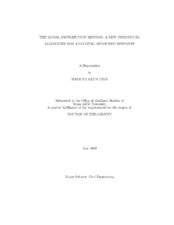| dc.description.abstract | A new statistical algorithm, the "modal distribution method", is proposed to
statistically quantify the significance of changes in mean frequencies of individual
modal vibrations of measured structural response data. In this new method, a power
spectrum of measured structural response is interpreted as being a series of independent modal responses, each of which is isolated over a frequency range and treated as
a statistical distribution. Pairs of corresponding individual modal distributions from
different segments are compared statistically.
The first version is the parametric MDM. This method is applicable to well-
separated modes having Gaussian shape. For application to situations in which the
signal is corrupted by noise, a new noise reduction methodology is developed and
implemented. Finally, a non-parametric version of the MDM based on the Central
Limit Theorem is proposed for application of MDM to general cases including closely
spaced peaks and high noise. Results from all three MDMs are compared through
application to simulated clean signals and the two extended MDMs are compared
through application to simulated noisy signals. As expected, the original parametric MDM is found to have the best performance if underlying requirements are met:
signals that are clean and have well-separated Gaussian mode shapes. In application
of nonparametric methods to Gaussian modes with high noise corruption, the noise reduction MDM is found to have lower probability of false alarms than the nonparametric MDM, though the nonparametric is more efficient at detecting changes.
In closely related work, the Hermite moment model is extended to highly skewed
data. The aim is to enable transformation from non-Gaussian modes to Gaussian
modes, which would provide the possibility of applying parametric MDM to well-
separated non-Gaussian modes. A new methodology to combine statistical moments
using a histogram is also developed for reliable continuous monitoring by means of
MDM.
The MDM is a general statistical method. Because of its general nature, it may
find a broad variety of applications, but it seems particularly well suited to structural
health monitoring applications because only very limited knowledge of the excitation
is required, and significant changes in computed power spectra may indicate changes,
such as structural damage. | en |


